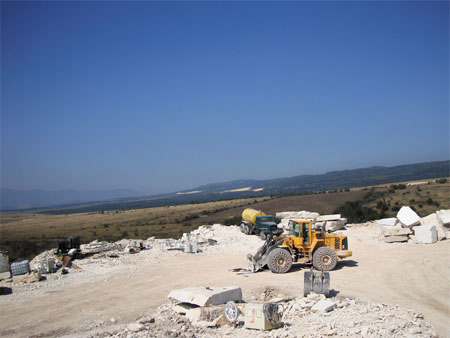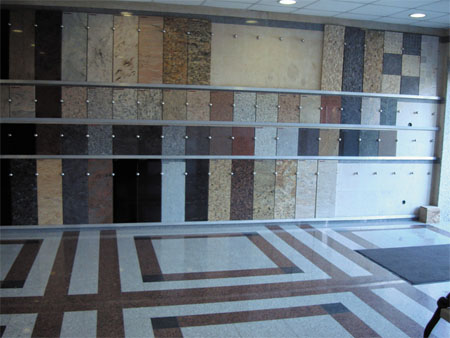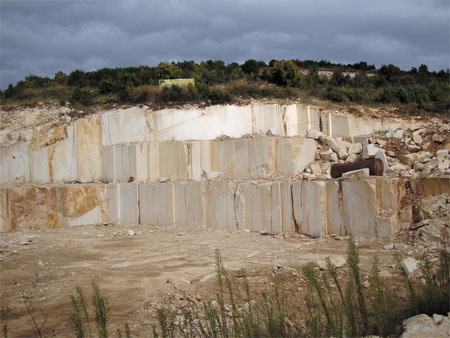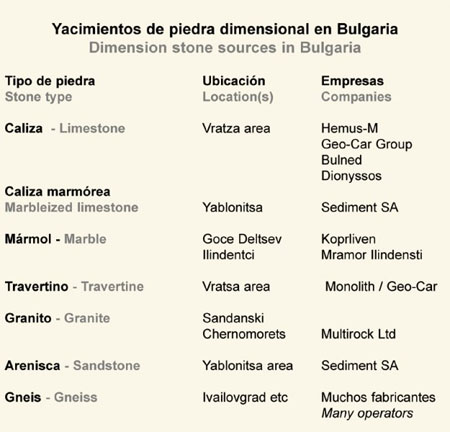Paul Daniel
Compared with neighbours Turkey and Greece, Bulgaria´s dimension stone industry is small. Vratsa limestone however has remained popular for a long time. The growth of private enterprise since 1989 has seen imports grow, and the market further developed with accession to the EU in 2007. But the past 2 years have not been easy.
A country of almost 8 million people, the Republic of Bulgaria shares borders with Romania, Serbia, Macedonia, Greece and Turkey. Around two-thirds of the 110.994 km2 land area is mountainous, so not surprisingly there are quite a few deposits of dimension stone. For economic reasons, not many are exploited commercially today whereas imports have grown very significantly. Based on visits in mid-September 2010, we profile today´s major Bulgarian quarrying, processing, importing, exporting and trading companies.
Spectacular stonescapes
For those with a broad interest in stone, there are several places in Bulgaria where there are spectacular rock formations. In the north-west near Belogradchik, limestone pinnacles rising up to 200 m in height appear in scarlet, buff and grey. Approaching Melnik in the south-west, famous for its wine, there are a series of sandstone cones. A "stone forest” can be seen about 18 km west of the city and Black Sea port of Varna. Limestone pillars up to 6 m in height were formed some 50 million years ago.
The stone industry in the 20th century
According to Denica Petkova of BULNED AMD, before the fall of the Communist regime there were around 54 quarries of varying size, 4 large factories and more than 24 small factories in Bulgaria. Post -1989 some were privatized by Bulgarian and foreign investors.
As elsewhere, decorative and dimension stone continues to find favour in Bulgaria today - in prestige shopping malls, public buildings, hotels, airport terminals, and in an increasing number of private homes. There is also a local memorial (tombstone) industry. Vratsa limestone and Mura crystalline marble are the traditional local materials used, supplemented by imported Chinese and Indian memorials.
Domestic sources
Very limited volumes of marble, marbleized limestone, granite, travertine, shellstone (muschelkalk), gneiss and sandstone are extracted at various localities in Bulgaria (see Table), almost always exclusively for local use. Some 115 km north-west of capital city Sofia however are extensive reserves of high quality limestones at various sites around the town of Vratsa. It was in 1893 that a local millionaire began building a spirits factory for which he needed large quantities of dimension stone with robust properties. He hired some Italian experts who knew there was white limestone in the region. They pinpointed a specific source, bought the land and hired around 40 local people to create a quarry.
Early Cretaceous limestone became known as “Vratsa stone” and it enjoys great popularity still today. The reason is that it has an elegant understated character with a colour ranging from white to light yellow, it is dense and hard wearing and it is frost resistant. A British importer states that it is the only white limestone they would recommend for use in a kitchen.
Vratsa limestone´s credentials and reference buildings are numerous, in Bulgaria and abroad. References in Sofia include the Alexander Nevsky Cathedral (exterior), National Palace of Culture, the Cyril and Methodious National Library, and Sofia University´s Rectors Building. Outside Bulgaria, the most prominent references include the Swaminararayan Mandir - a Hindu Temple in northwest London, England, the National Museum in Vienna, Austria, the University of Gothenburg in Sweden and the Royal Bank of Scotland.
Quarrying companies
Note: Only leading companies known to have been operating in September 2010 are listed below, in alphabetical order.
BULNED Ltd was established in 1998 and began block extraction in the same year. A processing factory was opened in 2002. BULNED AMD is the sales company selling on the local and foreign markets. The original BULNED quarry near Varbeshnitsa is no longer worked due to quality problems. An alternative source of Vratsa stone has been established at Gorna Kremena and early indications are that it is a strong, homogenous stone with good colour. Ample stocks of blocks are available until supplies from the new source are assured. Extraction at BULNED´s marble quarry has been temporarily suspended in view of current market conditions. A third quarry near Manastirishte, about 50 km west of Vratsa town, is the source of Vratsa shellstone or mushcelkalk. It has an attractive warm cream colour with a wavy pattern and like Vratsa limestone it has been used throughout Europe for more than 100 years.
DIONYSSOMARBLE-BULGARIA is a subsidiary of the well known Greek company. It operates a Vratsa limestone quarry said to have a production capacity of 7.000 m3 of gangsaw blocks per annum. More than 90% are exported, mainly to Greece.
GEO-CAR GROUP was established in 1995 and now owns 9 quarries in Northwest Bulgaria. In 1999 Geo-Car acquired Mramor Berkstone JSC, at the time with Bulgaria´s biggest factory for processing limestone, marble and travertine. Today Geo-Car says it is covers all aspects of natural stone, from extraction, importing from all over the world through to processing, and following with a complete installation service. Mr. George Shishkov is the owner and general manager of Geo-Car.
HEMUS-M is a member of the Venus Marble Group and it is the biggest producer of Vratsa limestone blocks in Bulgaria. The quarries are at Carevec and Dobravka near Vratsa. The material is sold in various colour shades and qualities, with Bravo Extra as the premium quality. The Sales manager is Nikolai Spasov.
ILINDENTCI MRAMOR has been extracting crystalline marble at a site near Ilindentci village in the area of Sandanski, south-western Bulgaria, for a very long time. There are four main qualities: Mura Contact Zone (cream), Mura Dark (greyish-blue), Mura Light (light grey) and Mura White. The quarry is large with over 30 terraces. Mura marble remains one of the most popular materials in Bulgaria for memorials / tombstones.
MONOLITH, MONTANA has three quarries - see Geo-Car Group.
PIRIN-MRAMOR AD owns three quarries and workshops for the processing of marble and granite. Products range from slabs and tiles through to balustrades, memorials and flower vases.
PISANI BULMAR LTD owns 3 quarries in Bulgaria. Its main material is Vratza limestone. The quarry at Gorna Kremena can produce around 300 m3 a month of blocks but due to the level of stocks it was not being operated at the time of the authors visit. Sales are coordinated by the Pisani group´s Greek company Lacomar-Pisani SA. The second quarry near Lessoura produces a ´mottled´ type Vratza which is relatively soft and only used for internal applications.
SEDIMENT SA was established in 1998 as a successor to Balkanskal, a formerly state-owned dimension stone extraction and processing enterprise with headquarters and factory in Yablanitsa about 80 km east of Sofia. Of 5 quarries owned 3 are currently active. Rumiantsevo yields a white marbleized limestone, Nanovitsa a grey limestone and another a possibly unique red sandstone used as cube setts. A quarry containing a material very similar in appearance to Noir Marquina from Spain is not currently being worked. Almost all the standard products from the small factory are consumed on the Bulgarian market.
Processing and trading companies
Note: This is a selection of leading companies, in alphabetical order.
ATIG Ltd was founded in 1994 and its main activity is the import of stone tiles, principally from Armenia.
BULGRANIT LTD is the biggest producer of granite slabs and tiles in Bulgaria. The original state company was founded in 1973 and it was privatised in 1998. The product range includes standard size and custom-made tiles, stairs, window sills, kitchen, bathroom and bar worktops, architectural parts, etc. Around 200 types of granite are imported from some 20 countries, mainly in slab form. Bulgranit is the only company in Bulgaria to possess a granite gang saw. The factory is equipped with modern machinery from Breton, Simec, Intermac, CMG etc. Products are sold today mainly on the domestic market. Managing director Dimitar Tsvetkov was most helpful when interviewed.
BULMARMA PLC was founded in 1997. The product range includes tiles, window sills, stairs, tables, balustrades and columns. The Bulmarma office is in Sofia and the processing works at a site near Pernik, about 20 km west of Sofia. The company also operates a smaller factory at Balchik to supply clients in the Black Sea area. Sales chief Gergana Koneva and her husband Ivan Konev, Production manager, reported ´difficult times with as much time spent trying to collect debts as on other business´.
BULNED Ltd´s factory is built on a 4.000 m2 site near Vratza town. It has a production capacity of more than 10.000 m2 of slabs and tiles per month. Equipment includes three gangsaws, from BM, Carl Meyer and Sermak, a Pellegrini monowire machine, sundry bridge saws, two tumbling machines, etc. Almost 100% of materials worked are of national origin. Marketing manager Denica Petkova explained that BULNED´s main export destinations include China, USA, Turkey and Greece. Noted Denica ´European markets are becoming less and less important to us. We are concentrating more and more on Asia.
BULSTON EOOD is a significant importing and processing company with headquarters in Lovech. The company has a wide range of materials imported and products.
BULSTONE LTD import and process stone from a variety of sources. The company was established in 1996 and the factory opened in 2007 is located outside the village of Topoli, near Varna on the Black Sea coast. More than 200 varieties of stone are said to be stocked.
FON SK is based in Ruse on the Danube and uses Spanish, Finnish, Norwegian, Indian, South African and Brazilian materials to produce a wide range of decorative stone objects, including balustrades, columns and sculptures.
GEO-CAR GROUP has two factories including Mramor Berkstone = see separate entry.
ITALCO Ltd. was established in the early 1990s and offers a wide selection of products made in the factory in Sofia.
MARMODOM LTD processes all types of stone mainly for interior decoration. The speciality is fireplaces with a decorative stone surround. It has showrooms in Sofia and Varna.
MGD is an abbreviation for Marble & Granite Design. With a showroom and works in Sofia, this company imports all types of stone including Alcantara Black Granite from Spain and processes Lilianovo granite from Bulgaria. The website www.mgd.bg features excellent pictures of materials and the very wide range of products. MGD was founded in 2004 and 50% of the materials worked are imported. Export destinations for MGD are principally Denmark, France and Macedonia.
MONOLIT 1994 PLOVDIV is said to be one of the top three stone processing companies in Bulgaria.
MRAMOR BERKSTONE JSC, Berkovitsa, was founded more than 50 years ago and was privatized in 1999. Almost all blocks are obtained from associate members of the Geo-Car Group, principally Monolith JSC, and only around 2% are imported. Mr. Ivo Sotirov, Trade manager, proved very knowledgeable and confirmed that Germany, Austria, Denmark, the USA West Coast, Hungary and Kuwait are today´s principal export destinations. Between 70-80% of Berkstone´s output is exported.
MULTIROCK CO. claims to have many years experience in the extraction and processing of stone, with two production complexes in Sofia and four quarries of granite and marble in Burgas region on the Black Sea.
PAPADOPULOS & SON LTD has a very impressive showroom on the outskirts of Sofia. Vivacious Sales & Marketing director Alexandra Terzieva Described Papadopulos as “a boutique stone company - the Antolini Luigi of the Balkans!” With some justification. The company owns a Vratza limestone quarry at Gorna Kremena (not worked at present) and two processing units built on a 12.000 m2 area. The company was founded in 1990 and imports granite, marble and limestone from all over the world - including Connemara green marble. Prior to the recession more than 400 materials were stocked, now maybe 300.
PREDSEDNIK LTD was founded just 2 years ago. Machines were acquired from Pisani in England.
SATURN LTD import various types of stone which are processed either at the company´s Selishte factory near Blagoevgrad or in Sofia.
SKV offers a whole range of materials for interior decor including natural stone and quartz surfaces.
YOTOV STONE LTD (formerly named Promremontstroy) operates the ´most advanced facility in Bulgaria´ for processing Vratza limestone and other calcareous materials´. The factory is located next to the main road near Mezdra and has a production capacity of around 40.000 m2 per month. A Pellegrini monowire machine is used for block squaring and cutting thick slabs. Export destinations include Austria, Norway, Greece, Poland, Germany and Romania.
Confederation of British Industry (CBI) market survey
In 2009 the Confederation of British Industry (CBI) published a 7-page market survey titled “The natural stone and stone products market in Bulgaria ". The survey covers consumption, production, imports, exports and ´doing business´. The survey noted that as elsewhere in Europe, future developments in the construction sector will be of crucial importance. EU funds will be available for Bulgaria until 2013.
According to the survey, about 84.000 tons of dimension stone blocks and slabs and some 77.000 tons of monumental and funeral products were produced in the country in 2007. In recent years Bulgarian processing companies have had fierce competition from overseas suppliers of finished stone products, especially in the tombstone and funeral products sector. Some 84.000 tons of natural stone and stone products were imported in 2007 whilst 89.000 tons were exported, according to the survey.
Finally like all other central and east European countries, the Bulgarian market is becoming increasingly dependent on imported stone. As we have seen, however, Vratsa limestone is likely to remain popular at home and abroad.
Just as in Spain, the crisis in the construction industry began around 2 years ago and nobody knows when it will end. There are some projects in Bulgaria, principally in Sofia, Plovdiv and at holiday complexes on the Black Sea coast, but nothing like as many as before. According to Alexandra Terzieva of Papadopulos & Son Ltd, in 2009 the Bulgarian government owed around 250 million € to private firms in the construction sector. In 2010 the government started to pay off some debts.






